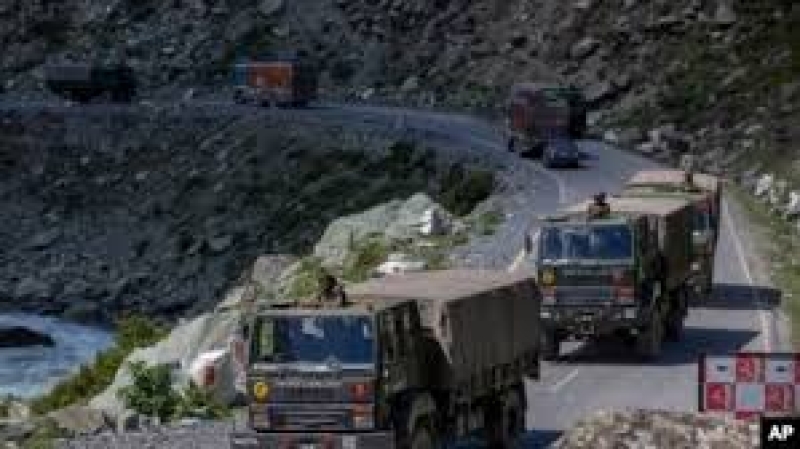- 2 Landmark Ordinances Passed to Strengthen Forest & Wildlife Protection |
- Zubaida Rahman heading to Dhaka to join Khaleda Zia’s UK flight |
- Israeli Assault Has Plunged Gaza Into Worst Economic Collapse |
- Woman sent to jail on charges of killing 8 puppies in Pabna |
- UN Assembly Urges Decisive Action to Resolve Israel-Palestine Conflict |
India-China military tensions persist even as their trade surges

As tensions between India and China persist with tens of thousands of soldiers confronting each other along their disputed Himalayan borders for a fifth year, analysts say they see few signs of a reduction in military tensions between the Asian rivals despite calls from both sides to stabilize ties. But trade between the two countries has surged.
“The ground reality is that the Chinese are focusing on building infrastructure in the Himalayas to enhance their conventional deterrence capabilities. They are building roads, bridges and other military-related construction. That is a huge concern for India,” Srikanth Kondapalli, dean of the School of International Studies at New Delhi’s Jawaharlal Nehru University told VOA.
Ties between the Asian rivals nosedived sharply following a clash in June 2020 between their soldiers. Backed by heavy artillery and fighter jets, an estimated 50,000 troops from each side still remain amassed at hotspots in the Himalayas, where they share a long, poorly demarcated border.
“I have to be honest, our relations with China are not doing very well,” Indian Foreign Minister Subrahmanyan Jaishankar told reporters at a news conference in Tokyo on Monday where he was attending a Quad meeting. “They are not good; they are not normal right now.”
Jaishankar’s remarks came days after he met his Chinese counterpart, Wang Yi, on the sidelines of a summit meeting of the ASEAN bloc in Laos last week where both sides emphasized the need to normalize ties.
In a statement after the meeting, Wang said that "it is in the interests of both sides to get China-India relations back on track." Jaishankar spoke of the need to address their bilateral issues “with a sense of purpose and urgency.”
But analysts point out there are no signs of de-escalation along the borders. Although soldiers withdrew from several conflict areas between 2020 and 2022, there has been little progress in resolving their disputes at other friction points that are claimed by both sides.
“We have had 21 meetings between military commanders from the two countries since the clash four years ago to resolve the issue, but progress has been marginal,” Kondapalli pointed out.
Even as the Indian and Chinese Himalayan border continues to be volatile, India’s imports from China have grown steadily despite strict curbs that New Delhi imposed on economic ties with China following the 2020 clash.
India had stepped up scrutiny of Chinese investments, blocked virtually all Chinese visitors, halted major Chinese projects in the country and blocked Chinese apps like TikTok.
Despite those restrictions, Beijing emerged as New Delhi’s top trading partner last year. India’s imports from China stood at more than $100 billion last year. India’s exports to China on the other hand were only $16 billion.
“When India put these curbs in 2020, the government strategy was that we should reduce our import dependence on China,” said Biswajit Dhar, trade analyst and Distinguished Professor at the Council for Social Development in New Delhi. “But that has not happened, so that strategy has come to grief and now there is a realization that there is no running away from the fact that it is difficult to decouple from China, which remains the world’s largest manufacturer.”
Indian Prime Minister Narendra Modi has led a push to make India an alternative manufacturing hub to China and companies like Apple have set up production facilities in the country in recent years. But several industries, including new factories coming up in the country remain reliant on imports from China, including machinery needed in manufacturing, reports VOA.
Industry groups have called on the government to relax strict visa curbs on Chinese nationals as they say they need Chinese engineers and technicians to install equipment and train Indian workers. New Delhi is considering speeding up visas for Chinese workers, according to media reports.
However, the government said it will not relax its curbs on Chinese investments after its Economic Survey, which highlights policy initiatives, argued in favor of attracting Chinese funds to address India’s growing trade deficit.
“To boost Indian manufacturing and plug India into the global supply chain, it is inevitable that India plugs itself into China’s supply chain. Whether we do so by relying solely on imports or partially through Chinese investments is a choice that India has to make,” the Economic Survey, released last week, stated.
India’s Commerce Minister Piyush Goyal however told reporters that there will be no rethink on Chinese investments.
While China says the two countries should resume normal exchanges even as they continue discussions on their territorial disputes, India maintains that putting ties back on track will be contingent on resolving the border standoff.
Analysts say New Delhi faces a dilemma. “The question is will India stick to its stand of not normalizing ties until the border issues are settled or whether they will modify their strict economic policy toward China,” according to Manoj Joshi, Distinguished Fellow at the Observer Research foundation in New Delhi told VOA. “But there is a growing feeling that we are boxed into a situation which is not comfortable for us.”

